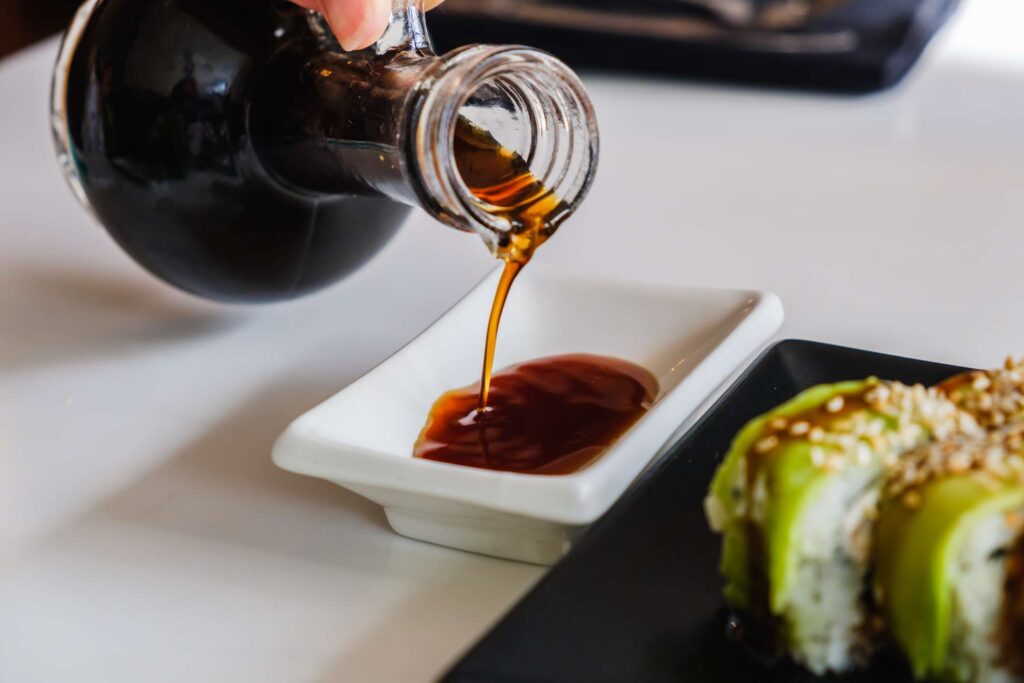Soy sauce is a fermented condiment made of soybeans and wheat. Coconut aminos is a dark brown sauce made by fermenting coconut palm sap. You can use both in stir-fries, soups, fried rice, noodles, marinades, dips, and salad dressings.
Coconut aminos is usually used as a soy sauce substitute, as both are a salty, dark brown sauce with a thin consistency. But there are some key differences between the two condiments:
Coconut aminos: Originating in Southeast Asia, coconut aminos is made by fermenting coconut palm sap (also called neera) with sea salt.
Soy sauce: Originating from East Asia, traditional soy sauce is made by fermenting soybeans and wheat with a mold called Aspergillus, or koji. Then, it is mixed with salty water and left to ferment. During this process, yeast and bacteria grow and give the sauce its flavor.
In addition to being made differently, coconut aminos and soy sauce each have distinct flavors, nutritional value, sodium content, and ingredients.
Flavor
Soy sauce and coconut aminos can both add a rich taste to meals, but they differ in flavor and aroma:
- Soy sauce: A complex umami and salty flavor, with caramel-like, floral, and malty aromas.
- Coconut aminos: A milder and sweeter taste, with less saltiness.
Nutrition
The nutritional value of 10 milliliters (ml) of soy sauce versus coconut aminos:
| Nutrition | Soy sauce | Coconut aminos |
| Calories | 5 kcal | 20 kcal |
| Carbohydrates | 0 grams (g) | 4 g |
| Added sugars | 0 g | 4 g |
| Protein | 1 g | 0 g |
| Sodium | 600 milligrams (mg), 26% of the Daily Value (DV) | 249 mg, 11 % of the DV |
Coconut aminos naturally contain small amounts of coconut sugar. It’s also slightly higher in calories.
Both soy sauce and coconut aminos are high-sodium condiments, but soy sauce has 2.4 times more sodium than coconut aminos.
Dietary guidelines recommend most adults eat less than 2,300 milligrams of sodium per day. Adding 10 milliliters of soy sauce covers almost one-third of the daily sodium limit. So, coconut aminos may be a better choice for people trying to lower their sodium intake.
Ingredients
Basic ingredients found in soy sauce and coconut aminos include:
- Soy sauce: Soybeans, wheat, salt, and water. It contains the allergens soy and wheat. Soy sauce is not suitable for people with gluten intolerance, celiac disease, or allergies to wheat or soy.
- Coconut aminos: Coconut blossom nectar, water, apple cider vinegar, and sea salt. People with a coconut allergy should avoid coconut aminos.
Some products also contain preservatives and added sugars. Check the ingredients list to see exactly what is included. Ingredients are listed in order from most to least used.
You can replace soy sauce with coconut aminos in most recipes. Here are a few tips and things to consider when using soy sauce and coconut aminos:
- Soy sauce and coconut aminos are often used in stir-fries, soups, fried rice, noodles, marinades, dips, and salad dressings.
- Coconut aminos will give dishes a slightly sweeter taste and be less salty compared to soy sauce. Adjust the amount of salt you use in dishes when adding coconut aminos instead of soy sauce.
- Add coconut aminos to stir-fries close to the end of cooking. This is because coconut aminos naturally contain sugar, which can caramelize quickly.
- Use coconut aminos when you want to create a caramelized crust on foods like meats and tofu.
- Mix coconut aminos with other ingredients like vinegar, lemon, lime, sesame oil, or chili to add flavor.
- Mix soy sauce with sweet ingredients like honey and brown sugar to decrease the perception of saltiness. Be aware that the sodium content won’t change by adding other ingredients.
Here are a few things to consider when choosing between soy sauce and coconut aminos:
- Availability: Soy sauces are widely available in supermarkets. You can find coconut aminos in some supermarkets or order them online.
- Cost: Soy sauce usually costs less than coconut aminos.
- Salt content: Coconut aminos have less sodium. You can also choose reduced-sodium soy varieties. The sodium content can slightly change from product to product as well. Read the nutrition facts labels to see the exact salt content.
- Allergies and intolerances: Coconut aminos are gluten-, wheat-, and soy-free, making them a good choice for people with wheat or soy allergies, gluten intolerance, or celiac disease. Soy sauce is suitable for people with coconut allergies.
You can also find gluten-free soy sauce in stores. A soy sauce variety called tamari is made solely from fermented soybeans, making it naturally gluten-free. However, some commercial tamari brands may still contain small amounts of wheat, so always check the product for a gluten-free label.


